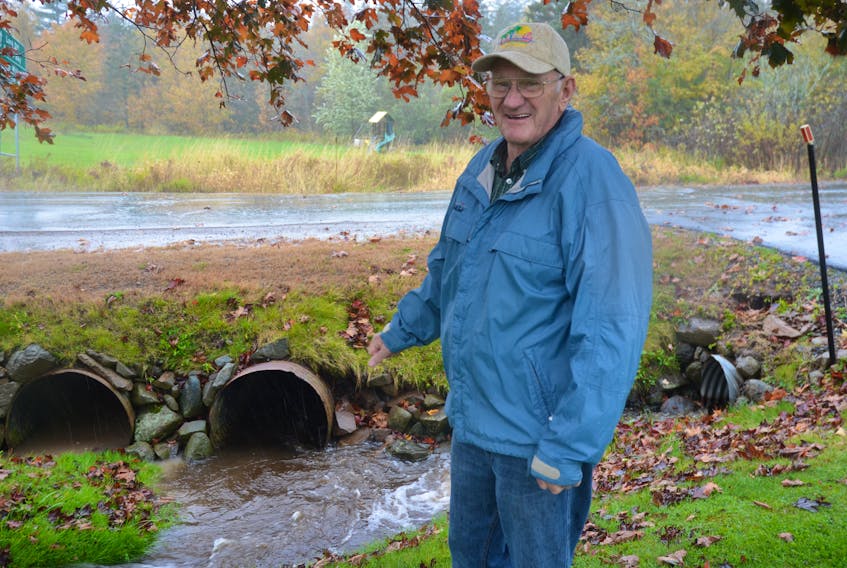It was the first time Everett Schofield had seen so much water in his basement at once.
Post-tropical storm Erin dumped enormous amounts of rain into Kings County that late-August weekend, bringing flooding with it.
And the first flood wasn’t the last.
It happened again not long after Erin.
“The first time we had six inches in the basement and the second time it got up to eight inches and ruined the deep freeze, and a whole lot of stuff,” Schofield said. “We had to move the dryer and washer, and the new deep freeze we had to purchase upstairs.”
Flooding, especially in his basement, has never been an issue at any other time in the 59 years Schofield has lived at his home in Glenmont.
“I don’t know whether it’s clearcutting, or just the times or climate change… we’re getting water like we’ve never had before.”
By the time the flooding was at its worst, water was starting to fill his yard and lap at the deck.
“The only salvation was the road,” Schofield said, noting that the road served as a barrier to stop more water from flowing into his yard. “Water finds its own level.’
He’s taken precautions, installing a gate valve in the basement drain, and a sewer pump.
There are already two culverts by Schofield’s home on Gospel Woods Road. Each culvert is about three feet below the road, set in a low-lying area. In both flooding events from Erin and post-tropical storm Dorian, the water overflowed and overran them.
Schofield spoke to engineers who said the road he lives on may get paved, something that could potentially help the situation, but he’s not convinced that’ll happen soon.
While giving Kings County News a tour of the property impacted by flooding, Schofield said he feels the solution could be for the Department of Transportation and Infrastructure Renewal (TIR) to build a new culvert northwest of where the two that flow beside his driveway are situated, ideally further up the hill in his front yard.
“That’d help some of the water that drains on that side flow out,” Schofield said. “All the water from up the road has to go through the culvert under my driveway.”
At the end of the day, he’d be happy with any action that would put an end to his water woes.
“They don’t need to replace the ones that are already here. They can put in bigger ones if they want,” he said. “I’m at an age where I don’t want that extra work. I just don’t want to have a bunch of backed-up water here again.”
His house, high above sea level near the top of North Mountain, is in a hollow surrounded by high banks.
On the other side of the hollow, Schofield said there’s a pond that contributed to flooding as water flowed downward.
“Water starts up on top of the mountain and comes this way and accumulates on the way. By the time it gets here, it’s big water,” he said.
FEELING HELPLESS
Graham Murray knew something had to give when he watched his property, and an adjacent farming field, flood with dark, muddy water.
Murray, who lives west of Centreville on Highway 221, knew the colour of the water meant it was overland flooding that seeped into his basement.
When post-tropical storm Erin arrived, vehicles were parked in a secondary driveway to make room for repairs on the house.
“That’s a little lower than the main driveway – just a couple of inches. We never had water come up to that part of the yard this early in the year,” Murray said. “Water came into the yard and flooded the cars, up to above the seats.”
Eventually, eight inches of the pooling water poured into Murray’s basement.
“At about 1:30 a.m. my roommate’s girlfriend said there was water in the basement. I went outside, and it was up to the front step,” Murray said. “By the car, it was up to my thighs, and if I went further back on the property I would have been up to my chest.”
The water eventually receded into ditches at about 5:30 a.m.
“It’s a feeling of helplessness,” Murray said, describing how it felt to watch the water rise. “It’s knowing you can’t do anything but let it happen.”
More flooding occurred when post-tropical storm Dorian arrived in the Valley.
Murray lays the blame for the flooding on inadequate infrastructure in the area. Normally, water drains through a ditch that feeds into a wooden culvert, eventually draining out into another ditch in an adjacent field.
“It’s supposed to pool there to keep flooding from happening and it’s done it for years.”
He said the only other time there was flooding was in the winter, due to snow and ice blockage.
When post-tropical storm Erin struck, the culvert couldn’t keep up with water throughout the night.
Murray found whirlpools forming around drainage areas, with water rising, reaching the road, and eventually flooding into other yards.
“The water couldn’t get underneath the road fast enough to where it needs to drain.”
Murray said TIR workers told him the cost of replacing the culvert by his property isn’t in this year’s budget.
He firmly believes an extra or larger culvert would have prevented the flooding.
MAKING IT POLITICAL
Kings MLA John Lohr has farmed in Kings County for three decades and has never seen six inches of rain accumulate in 24 hours.
“I don’t think it’s happened before in my lifetime, so that’s a big problem,” Lohr said. “It’s going to expose weakness in the systems.”
Schofield and Murray were not the only constituents lodging complaints with Lohr after the severe weather brought by Erin and Dorian.
They did, however, have something in common. Both cases were linked to culverts being overwhelmed in fast-paced flooding events.
“The week before Dorian, the road up to Scott’s Bay was all washed out,” Lohr said. “There were a number of people with flooded basements from the huge rainfall.”
Lohr stressed that the infrastructure in Kings County must be upgraded to the point that it can handle severe weather events.
“In the Scott’s Bay area, they put new pavement down about two years ago, and replaced a lot of those culverts, and in some cases home owners wanted to put in bigger culverts,” Lohr said.
He said the Department of Transportation and Infrastructure Renewal (TIR) disagreed, contending that the culverts in place were big enough.
“I don’t think it’s anyone’s fault. We haven’t seen flooding like this quite before. I don’t remember having that much rain in that short a time,” said Lohr. “There needs to be bigger culverts to handle the flow and better protect people’s homes and infrastructure.”
Lohr took the plight of his constituents to question period Oct. 4. He asked TIR minister Lloyd Hines if he would commit to reviewing culvert policy and replacing undersized and inadequate culverts in Kings County.
“I’d be very happy to work with the member on specific areas where homeowners feel they might be affected by the infrastructure from the department,” Hines replied.









